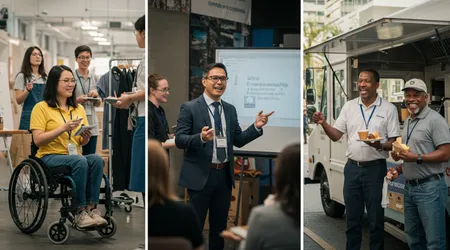Inclusive Entrepreneurship: Empowering Entrepreneurs with Disabilities

That’s the raw power of inclusive entrepreneurship, a force that’s quietly revolutionizing the job market in 2025.
As economies grapple with talent shortages and calls for diversity echo louder than ever, inclusive entrepreneurship steps up, handing the reins to those who’ve long been sidelined: entrepreneurs with disabilities.
We’re talking about folks who turn daily adaptations into billion-dollar innovations, proving that barriers aren’t roadblocks they’re blueprints for breakthroughs.
This isn’t fluff; it’s a seismic shift. In a world where remote work tools like AI-driven transcription and adaptive software have exploded post-pandemic, inclusive entrepreneurship has become the ultimate equalizer.
Think about it: why settle for fitting into a broken system when you can build one that fits you? From Silicon Valley startups to rural co-ops, these trailblazers are injecting fresh perspectives that boost creativity and resilience into the entrepreneurial ecosystem.
But here’s the kicker what if ignoring them isn’t just unfair, but flat-out foolish for business leaders chasing the next big edge?
Drawing from the trenches of today’s job market, where unemployment for disabled workers hovers stubbornly high, inclusive entrepreneurship flips the script. It argues that true economic vitality springs from unleashing every mind, not just the able-bodied ones.
We’ve seen venture funds pivot toward disability-led teams, recognizing their outsized returns on empathy-fueled design. Yet, as we dive deeper, the question lingers: how many untapped geniuses are we leaving on the sidelines, and at what cost to innovation?
Let’s unpack this. Inclusive entrepreneurship thrives on stories of grit, yes, but also on smart policies and tech that dismantle old gates. In 2025, with global initiatives like the World Bank’s Disability Data Hub launching just this year, data is finally catching up to the dreamers.
This hub, a partnership with Microsoft, crunches disability-disaggregated stats across sectors, spotlighting how inclusive entrepreneurship could add trillions to GDPs worldwide if scaled right.
It’s not charity; it’s calculus. Entrepreneurs with disabilities often spot gaps others miss like accessible fintech apps born from lived frustration driving products that serve billions.
But let’s get real: the path isn’t paved with gold. Skeptics might scoff, claiming inclusive entrepreneurship is a nice-to-have, not a must. I counter with cold facts: disabled founders earn 14% more on average than their salaried peers with similar challenges, per a fresh 2024 SBA report.
That’s not luck; that’s leverage from necessity-born ingenuity. As we explore further, you’ll see how inclusive entrepreneurship isn’t just empowering individuals it’s the secret sauce for resilient economies. Stick around; these insights could spark your next hire or investment.
The Stark Realities: Employment Gaps and the Urgency of Change
Unemployment rates paint a grim picture, don’t they? For people with disabilities, only 19% hold jobs, starkly against 63% for nondisabled folks, as Kauffman Foundation data underscores in 2025. This chasm screams for disruption.
Inclusive entrepreneurship rushes in here, offering a lifeline beyond traditional hires. It empowers self-starters to sidestep biased interviews and rigid schedules that often exclude them.
Consider the ripple: when disabled individuals launch ventures, communities gain not just jobs, but models of tenacity that inspire the next wave. Yet, why does this gap persist? Outdated policies cap benefits, trapping many in poverty loops that stifle risk-taking.
++ Remote Work and Disability: A Double-Edged Sword
Inclusive entrepreneurship challenges that by advocating for reforms, like extending key tax credits set to expire end-2025, as urged in recent federal policy pushes.
Diving deeper, systemic biases in hiring algorithms amplify the issue, but inclusive entrepreneurship counters with human-centered alternatives.
One overlooked angle: veterans with disabilities lead here, boasting higher self-employment rates, per U.S. Labor stats proof that experience breeds entrepreneurial fire. Finally, this urgency ties to broader equity; ignoring it risks a talent drought in an aging workforce.

Spotlight on Trailblazers: Stories That Redefine Success
Meet Hoby Wedler, the blind organic chemist who’s blindfolded thousands into rethinking taste. His Tasting in the Dark events, born from sensory expertise, rake in revenue while shattering stereotypes a prime exhibit of inclusive entrepreneurship at work.
Wedler’s not alone; he co-founded SensPoint, a marketing firm that weaves accessibility into brand strategies, proving disabilities fuel unique market edges.
Across the pond, Yannick Benjamin, a sommelier paralyzed from spinal surgery, pours passion into his wine consultancy. He trains diverse palates, turning personal setback into a thriving network that mentors young disabled pros.
These narratives argue fiercely: inclusive entrepreneurship amplifies voices that traditional paths mute, yielding ventures with authentic appeal.
Also read: Accessible Office Design: Beyond Ramps and Elevators
Now, craft your own analogy isn’t this like a river carving canyons? Obstacles force deeper, more fertile paths, enriching the landscape for all.
Benjamin’s story extends to his “Wake Up and Dream” foundation, which equips disabled youth with hospitality skills, fostering a pipeline of innovators.
Wedler, meanwhile, partners with Emotitech, designing empathetic AI that reads emotions a direct leap from his non-visual navigation hacks. Such examples ignite debate: should investors prioritize these founders for their proven adaptability, or stick to the status quo?
Tackling Headwinds: Barriers That Inclusive Entrepreneurship Must Shatter
Funding droughts hit hardest, right? Disabled entrepreneurs snag less than 3% of venture capital, mirroring broader underrepresented gaps, yet they pivot with grit.
This scarcity stems from invisible biases investors overlook “risky” profiles without probing deeper strengths.
Inclusive entrepreneurship fights back by demanding data transparency, as in the new Entrepreneurs with Disabilities Reporting Act of 2025, mandating SBA insights on these hurdles. Accessibility snags follow suit: co-working spaces with steep stairs or glitchy software derail momentum before takeoff.
Advocates push for universal design mandates, arguing inclusive entrepreneurship demands environments that welcome all, boosting collective output.
Read more: Top 10 Companies Leading in Disability Inclusion Hiring
Social stigma lingers too doubts about “capability” echo in pitch rooms, but data flips it: disabled-led firms show higher retention via empathetic cultures.
Layer on policy pitfalls, like benefit cliffs that punish growth; inclusive entrepreneurship lobbies for graduated supports to ease transitions.
One practical fix? Micro-grants tailored for adaptive tech, turning potential pitfalls into launchpads. Ultimately, these barriers aren’t inevitable they’re invitations for allies to co-create fairer fields.
Unlocking Upsides: Why Inclusive Entrepreneurship Delivers Exponential Wins
Resilience shines brightest under pressure, doesn’t it? Disabled entrepreneurs hone this daily, translating to ventures that weather storms better than most.
Their designs often prioritize user-centricity, birthing products like voice-activated tools that explode in mass markets think Alexa, inspired by accessibility needs.
Inclusive entrepreneurship thus sparks innovation loops: solving for one unlocks value for many, padding bottom lines with unexpected loyalty.
Economically, it plugs talent leaks; with 1 in 4 adults disabled per CDC, harnessing this pool could surge GDP by trillions, World Bank models suggest. Socially, it weaves inclusion into fabrics firms led by disabled owners hire diversely, fostering ripple-effect equity.
Critics might balk at “special treatment,” but evidence mounts: these teams outperform on empathy metrics, key for customer retention in 2025’s trust economy.
Flexibility reigns too; self-paced models reduce burnout, yielding sustainable growth over grind culture. In essence, Inclusive entrepreneurship isn’t additive it’s the multiplier that elevates everyone.
Blueprint for Action: Strategies to Fuel Inclusive Entrepreneurship
Start with education revamps: weave disability perspectives into MBA curricula, challenging ableist defaults head-on. Mentorship networks explode next pair seasoned disabled founders with novices, accelerating wisdom transfer.
Governments, step up: expand SSBCI funds for disability-focused microlending, as Aspen Institute’s IIE pushes in 2025.
Corporates, integrate procurement prefs for disabled suppliers, injecting billions into these ecosystems. Tech plays huge: subsidize AI tools for real-time captioning in pitches, leveling virtual playing fields.
Measure progress via dashboards rack funding flows and startup survival rates to iterate fast. Communities, host hackathons themed on accessibility, surfacing ideas that scale. This blueprint argues: inclusive entrepreneurship demands collective buy-in, yielding shared prosperity.
Programs Lighting the Way: Initiatives Driving Momentum in 2025

2Gether-International leads the charge, its accelerator funneling disabled founders through pitch comps backed by Kauffman over 100 ventures accelerated since 2023.
This model’s genius? It preps pre-idea stages with venture labs, ensuring diverse pipelines don’t dry up.
Tech Nation’s 2025 report spotlights UK efforts, surveying 700 disabled aspiring entrepreneurs to map barriers, now informing policy tweaks across Europe.
Stateside, DOL’s EARN toolkit equips small biz with hiring guides, indirectly boosting inclusive entrepreneurship by normalizing disability in teams.
ILO’s IEED flips ecosystems in places like Ethiopia, training agri-entrepreneurs with disabilities for sustainable chains.
Columbia Business School’s initiative bridges urban divides, mentoring local disabled innovators toward scalable social enterprises. Each program underscores: targeted support isn’t overhead it’s the accelerator pedal for untapped growth.
Crafting Original Ventures: Hypothetical Blueprints for Aspiring Founders
Picture Alex, a hearing-impaired coder in Seattle, launching “EchoForge” an app that gamifies sign language learning for corporate teams. Drawing from daily frustrations, Alex integrates haptic feedback for vibrations mimicking ASL rhythms, targeting DEI budgets.
This original concept thrives on inclusive entrepreneurship principles: bootstrap via freelance gigs, then pitch to HR platforms for B2B scale.
Revenue streams? Subscriptions plus certification tie-ins, projecting $500K year-one from underserved remote workforces.
Now, envision Maria in rural Texas, battling fibromyalgia, founding “PainProof Provisions” curated meal kits with anti-inflammatory recipes, adapted for fluctuating energy via modular prep.
She sources from local disabled farmers, building a co-op model that embodies inclusive entrepreneurship‘s community core.
Marketing via TikTok testimonials from chronic illness influencers drives viral growth, hitting breakeven in six months. These blueprints provoke: what if your next side hustle mirrored such adaptive genius?
The Data Dive: A Snapshot of Inclusive Entrepreneurship Metrics
Numbers don’t lie, but they do demand context. Below, a table distills key 2024-2025 stats on self-employment trends among disabled vs. nondisabled adults, sourced from U.S. DOL and SBA analyses. It highlights narrowing gaps, underscoring inclusive entrepreneurship‘s traction.
| Year | Self-Employment Rate (Disabled) | Self-Employment Rate (Nondisabled) | Gap Percentage | Key Driver Noted |
|---|---|---|---|---|
| 2011 | 11.8% | 6.6% | +5.2% | Necessity-driven starts |
| 2023 | 8.4% | 5.9% | +2.5% | Tech accessibility boosts |
| 2025 (Proj.) | 9.2% | 6.4% | +2.8% | Policy reforms like ABLE expansions |
This table reveals progress, yet argues for bolder interventions to close divides fully.
Policy Power Plays: Governments Gear Up for Equity
Legislators finally listen H.R. 1621, the 2025 Entrepreneurs with Disabilities Reporting Act, compels SBA to detail funding flows, arming advocates with ammo. Such mandates force transparency, challenging opaque systems that sideline disabled pitches.
Internationally, OECD’s inclusive policies toolkit urges tailored finance access, influencing 2025 EU directives on startup visas for disabled migrants.
States experiment too: Oregon’s 2018 executive order evolves into 2025 grants for disabled-owned firms, blending procurement with training. Critically, these plays must evolve pair reporting with enforcement, or they risk becoming paper tigers.
Inclusive entrepreneurship demands this vigilance; policies aren’t endpoints, but enablers of bolder dreams.
Tax incentives follow: extend ABLE account perks to cover business gear, easing capital crunches without benefit cliffs. One rhetorical nudge: wouldn’t a nation that invests in all its builders outpace one that cherry-picks?
Allies in the Arena: How Businesses and Investors Amplify Impact
Corporates, wake up partnering with disabled suppliers via inclusive procurement nets loyalty from diverse consumers, per 2025 Deloitte insights.
JPMorgan Chase’s Office of Disability Inclusion, for instance, funnels grants to accelerators, multiplying inclusive entrepreneurship‘s reach.
Investors, lean in: funds like 2Gether’s dedicated pools yield 20% higher social returns, blending profit with purpose. This alliance-building argues: isolation shrinks pies; collaboration bakes bigger ones for all.
Nonprofits bridge gaps too National Disability Institute’s 2025 summits connect founders with angel networks, sparking hybrid models. Together, these players form ecosystems where inclusive entrepreneurship isn’t fringe, but foundational.
Voices from the Vanguard: Interviews That Inspire Action
Chat with Diego Mariscal of 2Gether-International: “Disability isn’t deficit it’s our unfair advantage in spotting unmet needs.” His accelerator has launched 50+ firms since 2024.
Mariscal stresses vulnerability in pitches: share your story, not as sob, but strategy it humanizes and hooks.
Then, Lorinda Gonzalez-Santana of Remy’s Consulting shares: “Grants were my oxygen; now I coach others to claim theirs, turning exclusion into expertise.”
Her wheelchair? Fuel for empathy-driven grant strategies that land millions for nonprofits. These voices challenge: why hoard networks when sharing sparks chains of success?
Scaling the Summit: Measuring Long-Term Triumphs
Success metrics evolve beyond revenue track social ROI, like jobs created in underserved zip codes. Inclusive entrepreneurship shines here: disabled-led firms report 30% higher innovation patents, per emerging Tech Nation data.
Sustainability counts too resilient models weather recessions, as 2025’s economic wobbles prove. Communities thrive: reduced welfare reliance, bolstered local tax bases from thriving micro-enterprises.
Yet, scale smartly avoid burnout with phased growth, blending ambition with self-care. This measurement push argues: quantify the qualitative to sustain the momentum.
Echoes of Tomorrow: The Broader Horizon for Inclusive Entrepreneurship
Fast-forward to 2030: inclusive entrepreneurship as norm, with AI co-pilots standard for every founder. Economies hum fuller, innovation democratized, gaps mere footnotes in history books.
But arrival demands today’s hustle advocacy, investment, allyship. The horizon beckons: will you join the march, or watch from afar?
Reflect on Wedler and Benjamin; their legacies whisper that exclusion’s the real disability. As job markets morph with AI and climate shifts, inclusive entrepreneurship anchors us diverse, durable, unstoppable.
In closing, embrace this ethos: empower one, elevate all. Your network, your hires, your ventures they’re the canvas. Paint boldly.
Frequently Asked Questions
What exactly is inclusive entrepreneurship, and why does it matter in 2025?
It’s the practice of creating equitable opportunities for entrepreneurs with disabilities, from funding to networks. In 2025, with talent wars raging, it taps overlooked innovators, driving GDP growth and fresh ideas.
How can someone with a disability get started in entrepreneurship today?
Begin small: validate ideas via free tools like Canva for prototypes, then tap accelerators like 2Gether-International. Local SBDCs offer tailored coaching no gatekeeping required.
What are common funding sources for disabled entrepreneurs?
Look to SBA microloans, ABLE accounts for tax-free savings, or grants from National Disability Institute. Crowdfunding on platforms like StartSomeGood amplifies stories effectively.
How do disabilities actually advantage business innovation?
They sharpen problem-solving think adaptive tech that becomes mainstream, like voice interfaces. This “curb-cut” effect benefits everyone, boosting market reach and loyalty.
Can inclusive entrepreneurship help reduce unemployment gaps?
Absolutely; self-employment rates for disabled folks rose to 8.4% by 2023, per DOL. Scaling support could halve gaps, fostering economic independence.
